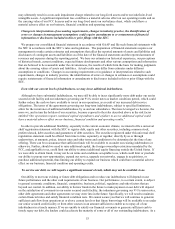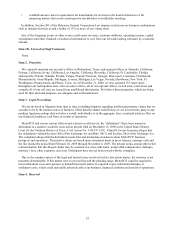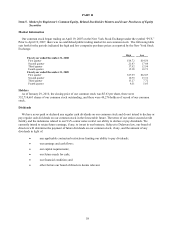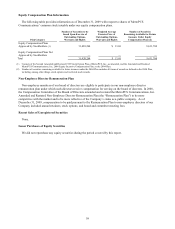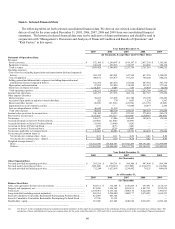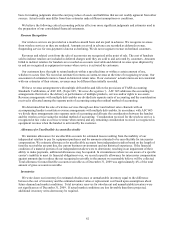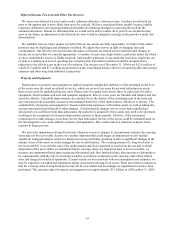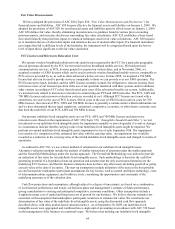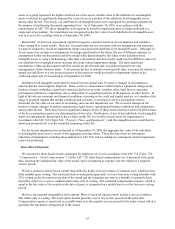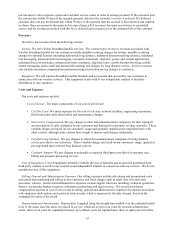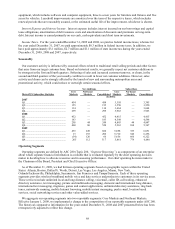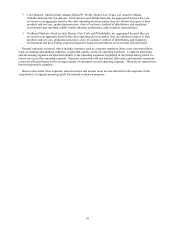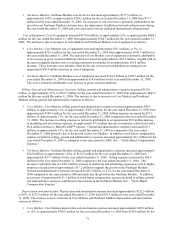Metro PCS 2009 Annual Report Download - page 74
Download and view the complete annual report
Please find page 74 of the 2009 Metro PCS annual report below. You can navigate through the pages in the report by either clicking on the pages listed below, or by using the keyword search tool below to find specific information within the annual report.62
basis for making judgments about the carrying values of assets and liabilities that are not readily apparent from other
sources. Actual results may differ from these estimates under different assumptions or conditions.
We believe the following critical accounting policies affect our more significant judgments and estimates used in
the preparation of our consolidated financial statements.
Revenue Recognition
Our wireless services are provided on a month-to-month basis and are paid in advance. We recognize revenues
from wireless services as they are rendered. Amounts received in advance are recorded as deferred revenue.
Suspending service for non-payment is known as hotlining. We do not recognize revenue on hotlined customers.
Revenues and related costs from the sale of accessories are recognized at the point of sale. The cost of handsets
sold to indirect retailers are included in deferred charges until they are sold to and activated by customers. Amounts
billed to indirect retailers for handsets are recorded as accounts receivable and deferred revenue upon shipment by
us and are recognized as equipment revenues when service is activated by customers.
Our customers have the right to return handsets within a specified time or within a certain amount of use,
whichever occurs first. We record an estimate for returns as contra-revenue at the time of recognizing revenue. Our
assessment of estimated returns is based on historical return rates. If our customers’ actual returns are not consistent
with our estimates of their returns, revenues may be different than initially recorded.
We have revenue arrangements with multiple deliverables and follow the provisions of FASB Accounting
Standards Codification, or ASC 605, (Topic 605, “Revenue Recognition”). ASC 605 addresses the accounting for
arrangements that involve the delivery or performance of multiple products, services and/or rights to use assets.
Revenue arrangements with multiple deliverables are divided into separate units of accounting and the consideration
received is allocated among the separate units of accounting using the residual method of accounting.
We determined that the sale of wireless services through our direct and indirect sales channels with an
accompanying handset constitutes revenue arrangements with multiple deliverables. In accordance with ASC 605
we divide these arrangements into separate units of accounting and allocate the consideration between the handset
and the wireless service using the residual method of accounting. Consideration received for the wireless service is
recognized at fair value as service revenue when earned, and any remaining consideration received is recognized as
equipment revenue when the handset is activated by the customer.
Allowance for Uncollectible Accounts Receivable
We maintain allowances for uncollectible accounts for estimated losses resulting from the inability of our
independent retailers to pay for equipment purchases and for amounts estimated to be uncollectible for intercarrier
compensation. We estimate allowances for uncollectible accounts from independent retailers based on the length of
time the receivables are past due, the current business environment and our historical experience. If the financial
condition of a material portion of our independent retailers were to deteriorate, resulting in an impairment of their
ability to make payments, additional allowances may be required. In circumstances where we are aware of a specific
carrier’s inability to meet its financial obligations to us, we record a specific allowance for intercarrier compensation
against amounts due to reduce the net recognized receivable to the amount we reasonably believe will be collected.
Total allowance for uncollectible accounts receivable as of December 31, 2009 was approximately 4% of the total
amount of gross accounts receivable.
Inventories
We write down our inventory for estimated obsolescence or unmarketable inventory equal to the difference
between the cost of inventory and the estimated market value or replacement cost based upon assumptions about
future demand and market conditions. Total inventory reserves for obsolescent and unmarketable inventory were
not significant as of December 31, 2009. If actual market conditions are less favorable than those projected,
additional inventory write-downs may be required.



